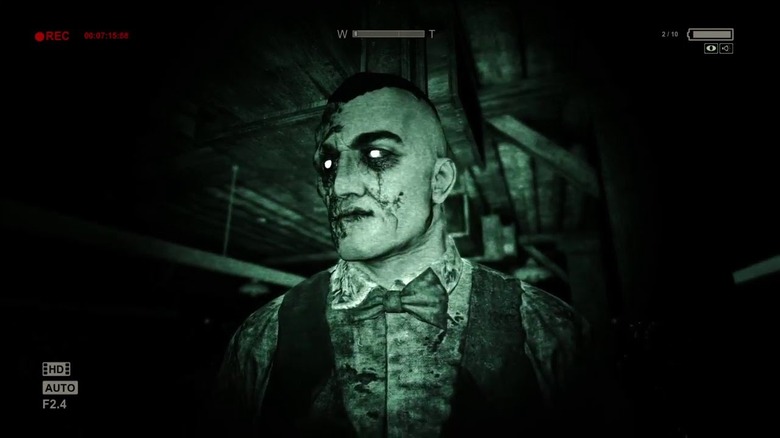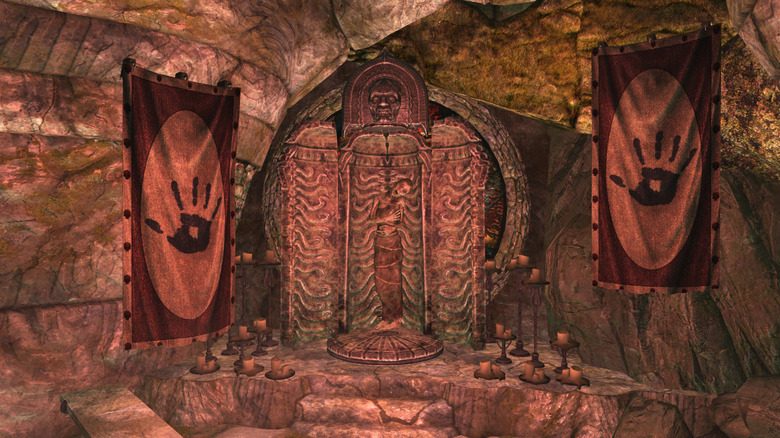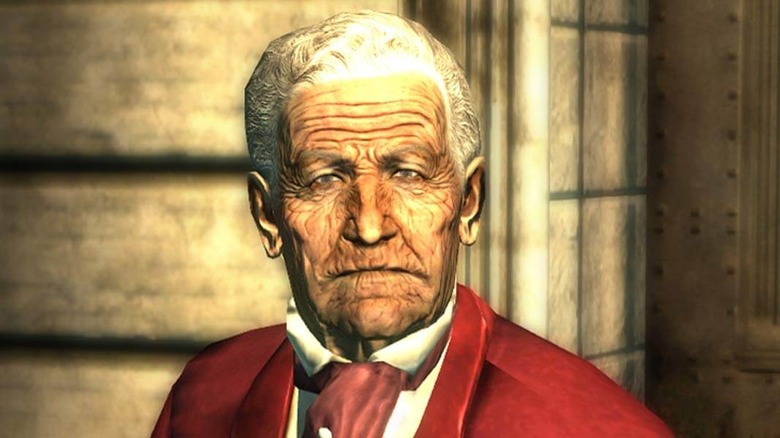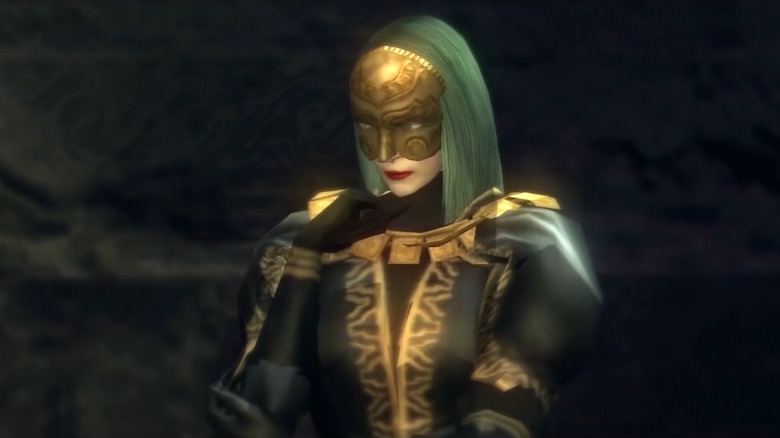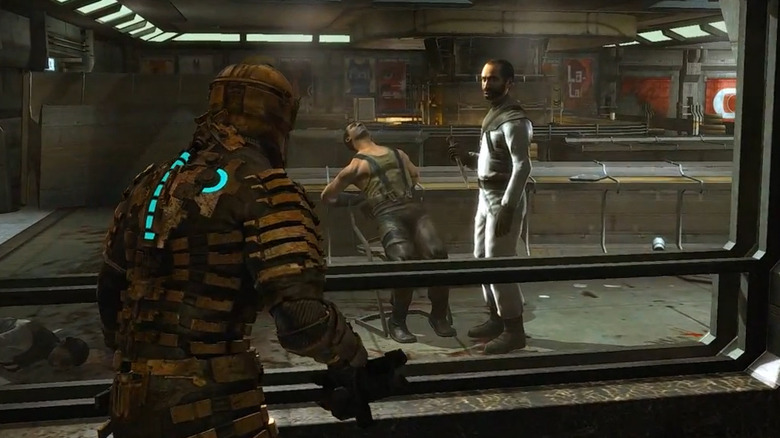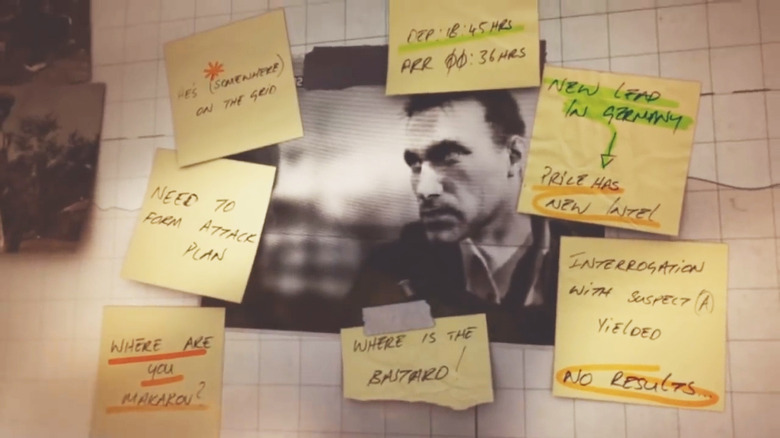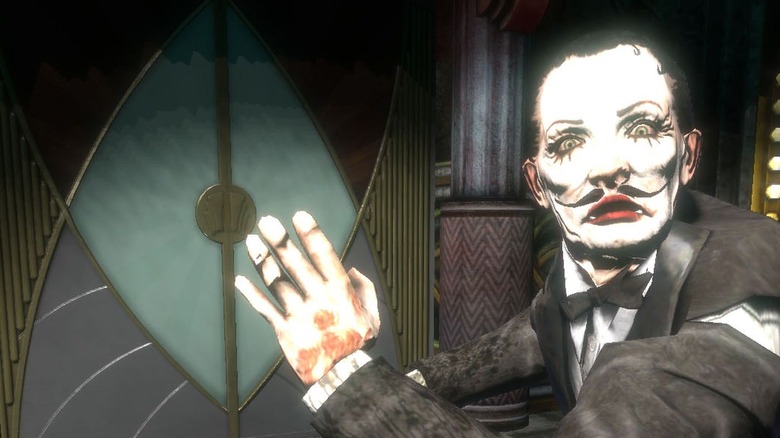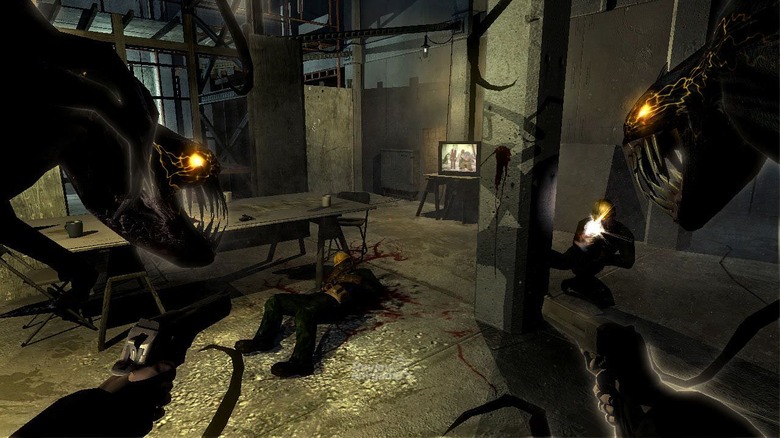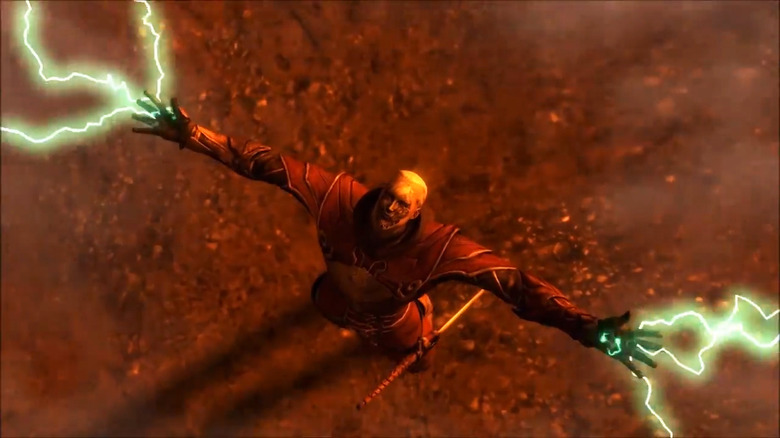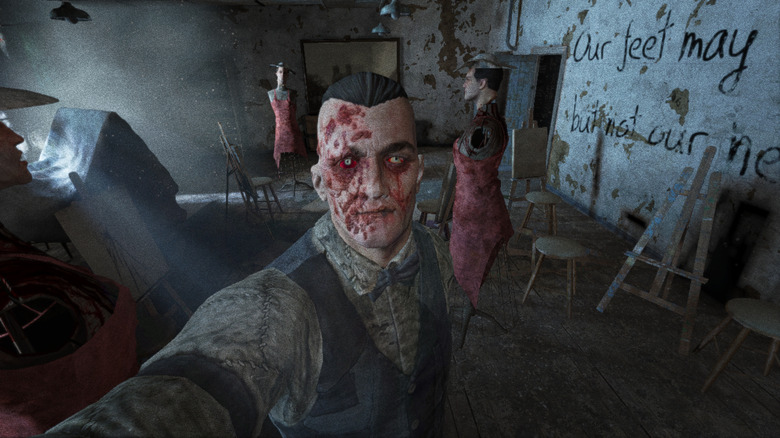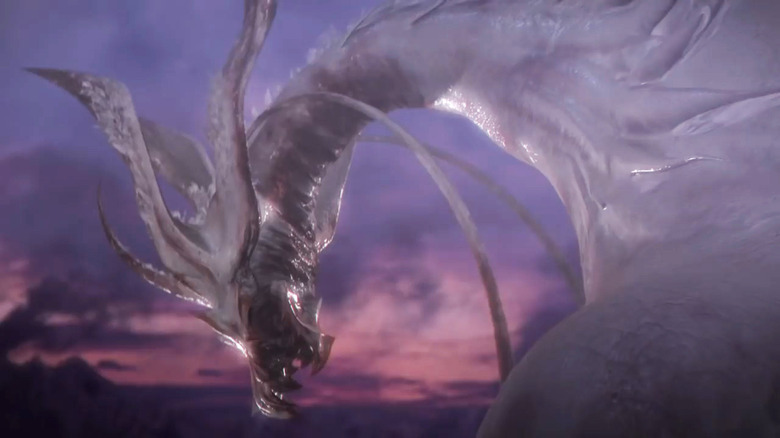The Darkest NPCs In Video Games
The phrase "non-player character" may have originated with pen-and-paper roleplaying games, but NPCs have been part of the video game landscape since the earliest days of the art form. Every category of video game has room for supporting characters that help guide the story. From enigmatic allies like the Old Man in The Legend of Zelda, to the accommodating Toads of the Super Mario Bros. franchise, NPCs have crossed over from RPGs into a wide range of genres and styles.
And just as video game narratives have grown more complex, so have the characters. The early influences of RPGs on character development are readily seen in latter-day games like Borderlands and Dark Souls that eagerly blur the genre line. And — as is the case with any art form — these modern games reflect modern perspectives, occasionally delving into the darker realms of human emotion to explore those troubled areas of the psyche we're unable (or reluctant) to explore in real life. In an effort to see exactly how far we've come from the faeries and merchants of Hyrule and the Mushroom Kingdom, we're taking a close look at NPCs that are seriously dark and totally twisted.
The Night Mother will embrace you all
A civil war, occult uprisings, draconic invasions: this is Skyrim, and the titular location of The Elder Scrolls V is no stranger to dark times. All manner of characters, both foul and fair, populate Tamriel's northern kingdom. And like any good Elder Scrolls title, Skyrim is replete with denizens of dubious desires and sinister agendas. Chief among these are the members of the Dark Brotherhood and their clandestine leader, The Night Mother.
This immortal matron of Skyrim's assassin's guild is not only the disembodied spirit of a rotting corpse, she compels the player to murder Emperor Titus Mede II and a score of his subjects during a radical effort to reform the guild. After the player spends countless hours earning the trust of Tamriel's deadly secret society, the Night Mother introduces a series of moral quandaries to the quest log involving the homicide of Skyrim's fair citizens.
These challenges are appropriately rewarded if overcome, but what price is ultimately paid during this sanguinary search for power? After all, "There are some that say the Dark Brotherhood is back, and stronger than ever" thanks to the Night Mother's surreptitious efforts. But the truth — much like the fate of Skyrim itself — is subjective. The Night Mother's epic questline fundamentally points a bony finger at the player; the darkest character of Skyrim is us.
Allistair Tenpenny wants an eyesore removed
The hazard-laden Capital Wasteland of Fallout 3 is full of killers, freaks, and madmen, so singling out the sickest of them all is no small feat. Enter Allistair Tenpenny, a loathsome NPC the Sole Survivor encounters during the game-defining quest known as "The Power of the Atom." After an introduction from his henchman, Mister Burke, Tenpenny solicits the player to take up his own private homicidal agenda.
According to Fallout 3 source code, Tenpenny is one of only nine named characters in the base game to have "Very Evil" Karma. This post-apocalyptic opportunist would have the player detonate a nuclear bomb in the Capital Wasteland settlement known as Megaton, horribly obliterating all of its inhabitants, only for a perverse sense of personal aesthetic gain. Tenpenny's depravity is disgustingly simple, and — despite the veneer of Fallout absurdity — all too familiar when compared to some of the more radical transgressions of the real world.
Ultimately, Tenpenny's plan amounts to genocide masquerading as class warfare. And true to Bethesda's open-ended RPG formula, it's up to the player to decide whether to support or condemn Tenpenny's maniacal crusade. "I almost wish there was another nuke we could detonate," the old miser squeals if you take his side. It goes without saying: he's not much of a "people person."
Mephistopheles will only talk to the worst players
In case you missed it, FromSoftware's award-winning Demon's Souls is the cult-classic progenitor of the Dark Souls series. When this PlayStation exclusive hit the streets in 2009, many players weren't quite ready for its special blend of action, RPG, and dark fantasy. Those who were found themselves wonderfully immersed in the forlorn world of Boletaria — an oblique fantasy landscape full of friends and foes of mysterious origins and covert motivations.
As Demon's Souls' cast of non-player characters slowly coalesces throughout the game, one subject in particular raises suspicion above all others: the rogue known as Mephistopheles. This enigmatic evil woman, who can only be encountered by players with a Pure Black Character Tendency (read: utterly evil characters), is a high-ranking official in a masked society that seeks to harness the power of Souls. After gaining the trust of the Slayer of Demons (i.e., the player), she compels him to murder each of the rest area's key NPCs one by one. This hit list begins with Yurt, the Silent Chief, a detestable assassin whose only purpose in Boletaria seems to be assisting Mephistopheles. (Oh, the irony). Among the ill-gotten rewards she bestows, the Foe's Ring in particular "supports treachery against others, since its bearer raids warriors in other worlds and devours their Souls."
In a game as dark and inscrutable as Demon's Souls, the elusive and sinister Mephistopheles manages to confound like no other.
Challus Mercer saw the beauty in horror
Dead Space from EA Redwood Shores (aka Visceral Games) is an award-winning testament to the limitlessness of the horror genre and the dark corners of human ingenuity. Part hard sci-fi, part survival horror, and totally terrifying, Dead Space finds protagonist Isaac Clarke navigating his way through the derelict spacecraft USG Ishimura — the "Planet Cracker"-class flagship of the Concordance Extraction Corporation — which has been overrun by a host of mutating reanimated creatures known as Necromorphs. As he pieces together the fragmented story of the Ishimura's demise, Isaac encounters a handful of survivors clinging to various states of sanity. And Dr. Challus Mercer — scientist, zealot, and madman — is arguably responsible for a great many of these lost minds.
An advocate of mass suicide and a collector of severed limbs, the Unitologist Challus Mercer is something of a post-modern poster boy for the mad scientist trope. He became fanatically obsessed with the Necromorphs that infested the Ishimura, to the extent of creating his own new species: the Hunter. The deranged doctor even conducted insane experiments on the Ishimura's crew, believing that the Necromorph infection — which provided life after death — was an evolution of the human race. Many players also theorize that Mercer was actually the one responsible for sabotaging the USG Ishimura's escape pods. In the words of the mad Dr. Mercer himself, "The future of our race ends here!"
Vladimir Makarov fights for neither flag nor ideals
This primary antagonist of the Modern Warfare franchise operates at the pinnacle of dark realism. Following the assassination of arms dealer Imran Zakhaev in Call of Duty 4: Modern Warfare, Vladimir Makarov — also known as the First Horseman — assumed control of a large complement of the despot's resources, rising to power in Modern Warfare 2. As Lieutenant General Shepherd puts it: "This man Makarov is fighting his own war and he has no rules. No boundaries. He doesn't flinch at torture, human trafficking, or genocide. He's not loyal to a flag or country or any set of ideals. He trades blood for money."
The stone cold (nigh inhuman) agenda behind the "No Russian" mission in Modern Warfare 2 is a razor sharp example of the depth of his depravity. During a terrorist assault on Zakhaev International Airport, Makarov and his men slaughter hundreds of innocent civilians in a successful effort to blow the lid on undercover CIA agent Joseph Allen (the chapter's protagonist) and implicate the United States in the attack. The result was all-out war in the continuity of the Modern Warfare universe. Shepherd was right about one thing: Makarov is a "mad-dog killer for the highest-bidder", and his success as a recurring antagonistic NPC is gut-wrenching. As Kotaku's Patrick Klepek maintains, "Even today, the stage that made players a terrorist remains shocking."
Sander Cohen will never compromise his art
With a staggering list of critical awards to its credit, BioShock from 2K Games has already become a legendary example of mixed genre in video game storytelling; and its unique amalgam of alternate history and sci-fi horror expertly highlights the darker facets of human nature. Rapture, the dystopian city beneath the sea wherein BioShock is set, is home to a wide host of ADAM-hungry enemies that oppose our hero at every turn. And — from the city's megalomaniacal founder at the top, to the lowliest deranged Splicers at the bottom — everyone's gone absolutely, over-the-rainbow crazy.
At the end of the day, the sadistic "artist" known as Sander Cohen is arguably Rapture's darkest denizen. After the city's downward spiral into chaos, this multi-hyphenate lunatic went stark raving mad and decided to decorate his Fort Frolic abode with the plaster-covered corpses of scores of dead Splicers. During the events of BioShock, Cohen derails the protagonist by forcing him to participate in an insane art installation involving mischief, mayhem, and murder/suicide — he asks the player to locate three of his crackpot splicer disciples and "immortalize their mortality" in his Quadtych (a presentation of four macabre art pieces in the center of his Fort Frolic lair) before attacking the player directly. Take it from Atlas: Cohen's "a real lunatic, a dyed-in-the-wool psychopath..."
The Darkness makes you a lord of demons
The Darkness from 2K Games — based on the Top Cow Productions comic book of the same name — tells the story of New York mobster Jackie Estacado, who inherits the blessing (and curse) of "The Darkness" after his 21st birthday. Top Cow describes The Darkness as "an elemental force that allows those who wield it access to an otherworldly dimension and control over the demons who dwell there." Naturally, the forces of good — known as "The Angelus" — rise up to oppose Jackie and his gift. But in this epic saga from Garth Ennis, Marc Silvestri & company, the good guys are really the bad guys.
The relationship between Jackie and The Darkness is a complex one, and the video game adaptation from Starbreeze Studios (as well as the sequel from Digital Extremes) bring it to glorious, gruesome life. Voiced by Faith No More's Mike Patton, the titular Darkness is an archetypal character loaded with modern sensibilities. Compelling dialogue and eye-catching visuals help realize one of the more likable anti-heroes in recent memory. And, due to the unique nature of the supernatural elements of the story, this is one supporting character who remains connected throughout the entire narrative. Appropriately, Jackie Estacado's tale is a Faustian one, complete with insurmountable woe. IGN's Hilary Goldstein called The Darkness "a wonderfully gruesome adventure" with "some truly dark and even shocking moments in the story."
Zobek is manipulating you all along
The Castlevania franchise is a beloved forerunner of the horror genre in video gaming. And even though this action-platformer series from Konami is more focused on pulse-pounding adventure than scary atmospheres, the games themselves have effortlessly unified a world's worth of mythology and legends under one supremely satisfying gothic horror banner. The characters who inhabit the Castlevania games, including of course the Belmont clan and their accursed lineage, are often forlorn in the face of a cruel world of foul terrors.
Despite its liberal reconstruction of the Castlevania mythos, Lords of Shadow from MercurySteam and Kojima Productions is no exception — and its cast of characters is among the darkest and most depraved of the series. The darkest of these? A would-be ally who reveals himself to be one of your worst enemies. Zobek, one of the three founders of the Brotherhood of Light, mentors Gabriel Belmont throughout the early course of his adventure; but this complex character is actually the dark Lord of the Necromancers.
Spoiler alert: the final Lord of Shadow was lurking among you all along. And he manipulated you into killing your wife with an evil artifact while he was possessed by Satan. That's a pretty dark turn of event, friends. But Zobek warned us during the game's opening lines: "We go about our daily lives never knowing the forces than can change our destinies forever; we are oblivious, ignorant like sheep to the slaughter."
Eddie Gluskin just wants to butcher you, that's all
Outlast from Red Barrels is a first-person survival horror game that Joystiq calls "the perfect nightmare." It tells the story of Mount Massive Asylum, a long-abandoned home for the mentally ill nestled among the Colorado mountains, and the dubious "research and charity" branch of the transnational Murkoff Corporation who operates in secrecy there (and by "operates in secrecy" we mean "performs hideous Nazi experiments on the inmates"). In Outlast's Whistleblower DLC, players assume the role of Waylon Park, a software engineer on a mission to unmask Mount Massive's rotten core.
On his trip to the dark and twisted center of it all, Waylon encounters some of the worst that Mount Massive has to offer; and the Variant known as Eddie Gluskin is definitely a contender for the asylum's most murderous madman. This deranged inmate of Mount Massive is a misogynistic serial killer who mutilates and fetishises his victims in order to construct his demented idea of a family unit. Known as "the Man Downstairs" and "the Thing Below," he antagonizes the titular whistleblower Waylon Park to the brink of sanity, climaxing in a torture porn cutscene that would even make gag-master Takashi Miike squirm. "Darling, I need you to try to bleed less."
Seath the Scaleless was the worst of the very worst
If you look up "grimdark" in the modern video game dictionary, you'll find a description of Dark Souls next to the image of a smoldering bonfire. On the critically-acclaimed heels of Demon's Souls, this FromSoftware franchise proudly straddles the line of adventure game and RPG while channeling a vibe that borders on horrific. Every character in Dark Souls seems doomed or damned, and an existential pall hangs about its protagonists at every turn. Among the wretched souls that occupy the forsaken lands of Lordran, the darkest and most twisted may very well be Seath the Scaleless, the Duke of Anor Londo.
The legacy of this diabolical traitor can be traced far along the timeline of Dark Souls mythology. According to the game's opening narration, "Seath the Scaleless betrayed his own, and the Dragons were no more." After murdering his kin, Seath retired to the Archives in Anor Londo, where he gathered slaves and conducted twisted experiments of gruesome arcane morphology in an endless quest for maddening power. Among the subjects of his terrifying research were saints, mystics, and would-be saviors — all horribly mutated by Seath's magics. It's awfully hard to be the darkest character in Dark Souls, but Seath's genocidal treachery and special brand of unfettered insanity puts him at the top of the list.

